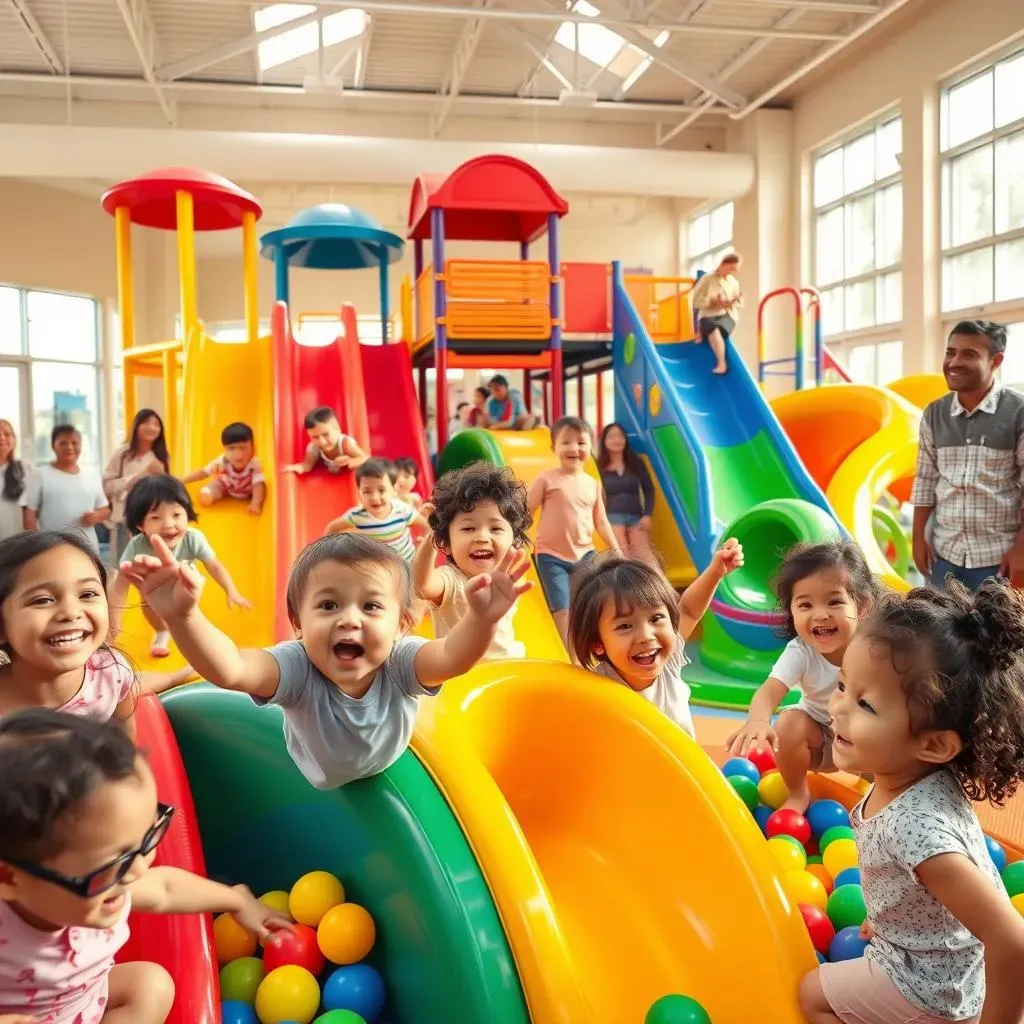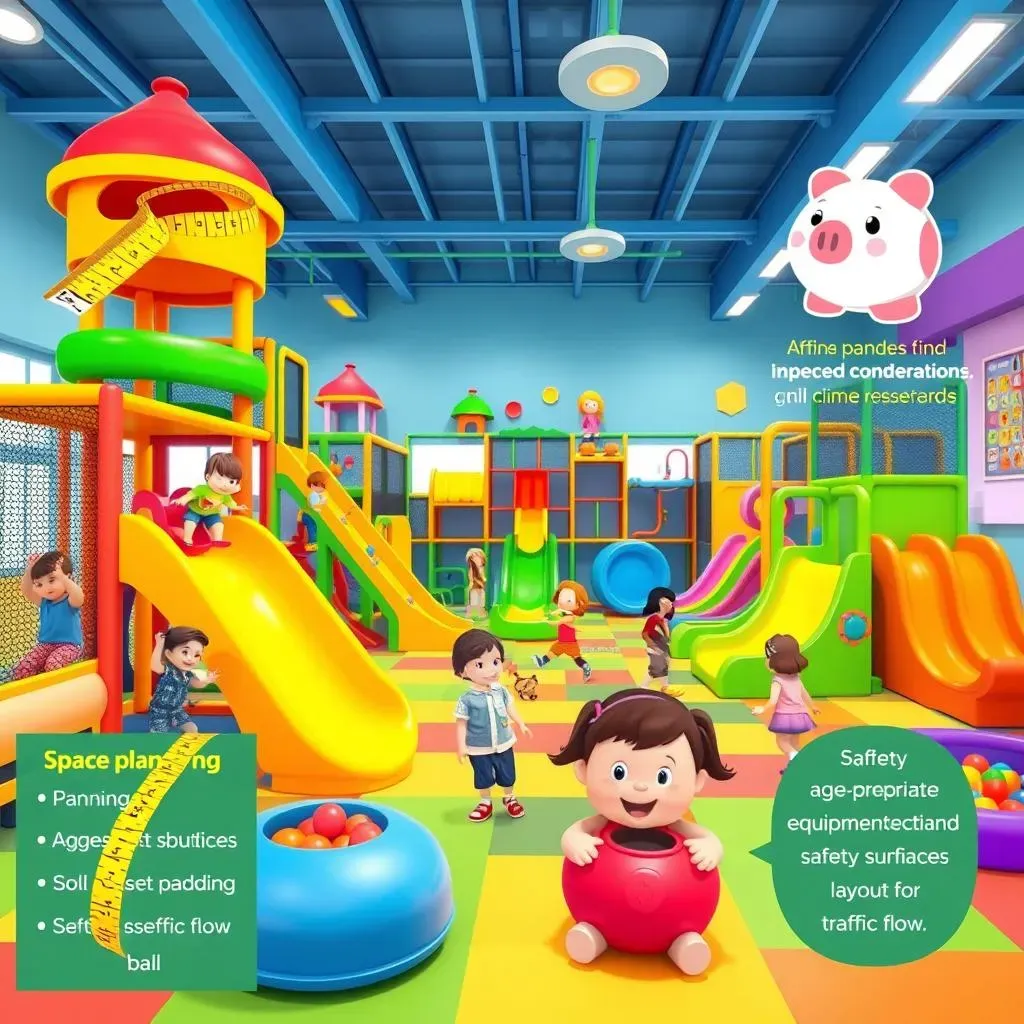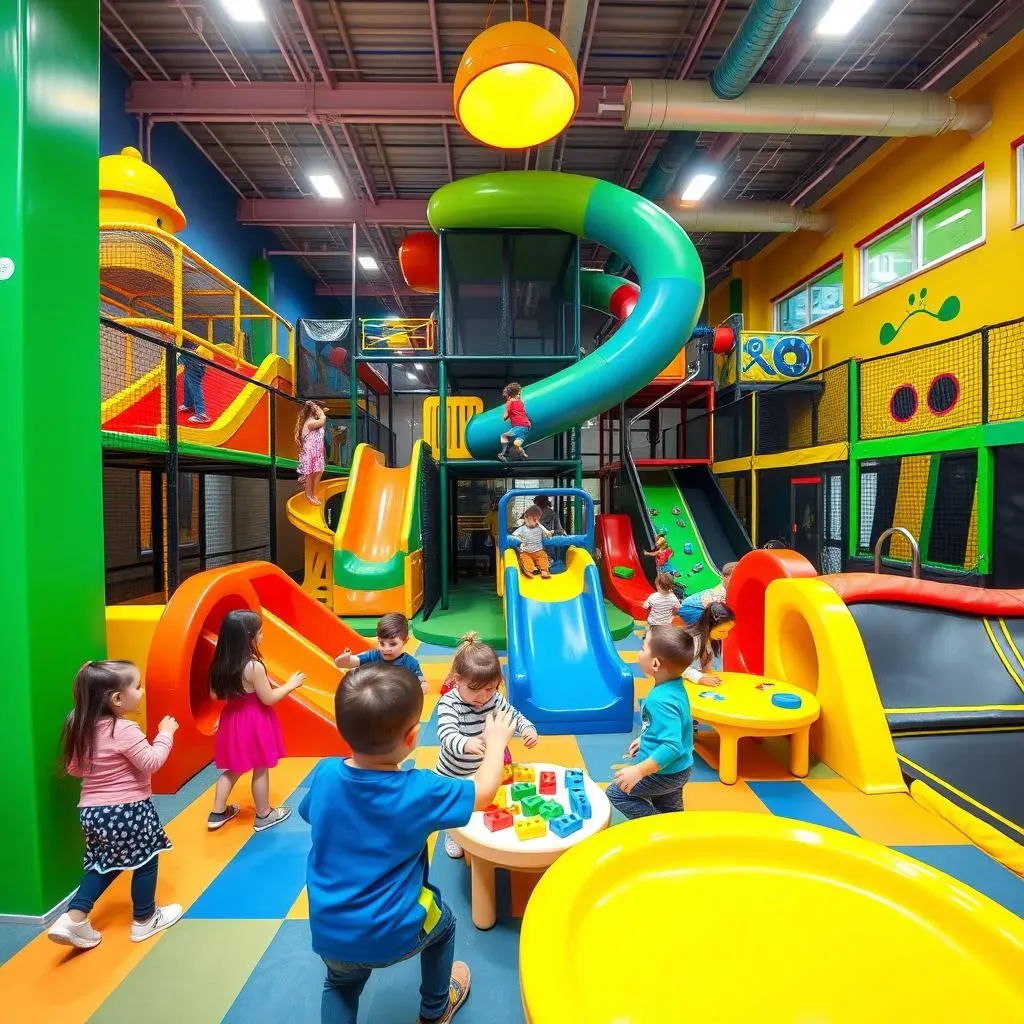Table of Contents
Looking to create a fun, safe, and engaging space for kids? Then you've come to the right place! This guide dives deep into the world of children's indoor playground equipment, offering everything you need to know to make informed decisions. Whether you're outfitting a family entertainment center, a daycare, or even a spacious home playroom, choosing the right equipment is crucial for maximizing fun and ensuring safety. We'll explore the benefits of indoor playgrounds, from promoting physical activity to fostering social interaction. But it's not just about the fun and games. Selecting the appropriate children's indoor playground equipment requires careful consideration of factors like space, budget, and the age range of the children who will be using it. We'll walk you through the key considerations, including safety standards, materials, and design options. Then, we'll showcase some of the most popular types of equipment available, from classic ball pits and slides to innovative climbing structures and interactive games. Finally, we'll cover essential safety protocols and maintenance tips to keep your playground in top condition for years to come. So, buckle up and get ready to transform your space into a kid-friendly paradise!
Why Invest in Children's Indoor Playground Equipment?

Why Invest in Children's Indoor Playground Equipment?
So, you're thinking about investing in children's indoor playground equipment? Awesome! Let me tell you, it's not just about creating a fun zone (though, let's be real, that's a HUGE part of it!). It's about investing in kids' physical and mental development, boosting your business (if you're in that game), and providing a safe, controlled environment for play, rain or shine. Think about it: kids need to move, explore, and socialize. Indoor playgrounds offer a fantastic solution, especially when the weather outside is frightful or space is limited.
Seriously, the benefits are massive. From a business perspective, indoor playgrounds can be a major draw for families, increasing foot traffic and revenue. Parents are always looking for safe, engaging activities for their kids, and a well-designed indoor playground can be a total game-changer. Plus, it's not just for entertainment centers. Daycares, schools, and even restaurants are incorporating indoor play areas to attract customers and provide added value. But even if this is for your home, imagine the hours of entertainment, exercise, and happy memories you'll be creating! It's an investment in your kids' well-being and your own peace of mind.
Benefit | Description |
|---|---|
Physical Activity | Encourages movement and exercise, combating sedentary lifestyles. |
Social Interaction | Provides opportunities for children to interact, cooperate, and develop social skills. |
Cognitive Development | Stimulates creativity, problem-solving, and imaginative play. |
Safe Play Environment | Offers a controlled and supervised space for children to play without the risks of outdoor environments. |
Business Advantage | Attracts families, increases foot traffic, and enhances customer experience for businesses. |
I mean, think about the alternative. Kids cooped up inside, glued to screens, bouncing off the walls with pent-up energy. An indoor playground is a healthy, active alternative that promotes physical fitness and reduces screen time. Plus, it's a fantastic way for kids to develop social skills. They learn to share, take turns, and cooperate with others, all while having a blast. And let's not forget the cognitive benefits. Indoor playgrounds encourage imaginative play, problem-solving, and creativity. It's a win-win-win!
Don't just take my word for it. Talk to other parents, business owners, or educators who have invested in children's indoor playground equipment. You'll hear stories of increased engagement, happier kids, and a positive impact on their overall well-being. It's an investment that pays off in so many ways. So, are you ready to take the plunge and create a space where kids can thrive? Let's dive into the next section and explore the key considerations you need to keep in mind when choosing the right equipment.
Key Considerations When Choosing Children's Indoor Playground Equipment

Key Considerations When Choosing Children's Indoor Playground Equipment
Alright, so you're sold on the idea of an indoor playground. Now comes the fun (and slightly overwhelming) part: choosing the right children's indoor playground equipment. Don't just rush out and buy the flashiest thing you see! There are several key considerations to keep in mind to ensure you're making a smart investment that will provide years of safe, engaging play. We're talking about things like space, budget, age appropriateness, safety standards, and the overall design and layout. It's a bit like putting together a puzzle, but the end result is a super awesome play space!
First things first: space. Measure, measure, measure! You need to know exactly how much square footage you're working with, including ceiling height. Trust me, you don't want to order a massive climbing structure only to find out it doesn't fit. Also, consider the layout of the space. Are there any columns, doorways, or other obstacles that you need to work around? Think about traffic flow, too. You want kids to be able to move freely and safely throughout the play area without bumping into each other or getting stuck in bottlenecks.
Next up: budget. Indoor playground equipment can range from relatively inexpensive to seriously pricey, so it's important to set a realistic budget and stick to it. Don't forget to factor in installation costs, as well as ongoing maintenance and repairs. Remember, cheaper isn't always better. Investing in high-quality, durable equipment will save you money in the long run and ensure the safety of the children using it. It's like buying a good pair of shoes – they might cost more upfront, but they'll last longer and be more comfortable.
Age appropriateness is another crucial factor. What age range are you designing the playground for? Toddlers have different needs and abilities than older children, so you'll want to choose equipment that is appropriate for their developmental stage. Toddler areas should be designed with soft, low-to-the-ground structures, while older children might enjoy more challenging climbing walls and slides. A mixed-age playground should have a variety of equipment to cater to different skill levels. And let's not forget about accessibility! Make sure the playground is accessible to children with disabilities, so everyone can join in the fun.
- Space: Measure your area accurately, considering height and obstacles.
- Budget: Set a realistic budget, including installation and maintenance.
- Age Appropriateness: Choose equipment suitable for the intended age range.
- Safety Standards: Prioritize equipment that meets or exceeds safety regulations.
- Design & Layout: Plan for traffic flow, accessibility, and visual appeal.
Popular Types of Children's Indoor Playground Equipment

Popular Types of Children's Indoor Playground Equipment
Classic Fun: Play Structures and Slides
When you think of children's indoor playground equipment, what's the first thing that comes to mind? For me, it's those awesome, multi-tiered play structures with slides, tunnels, and climbing areas! These are the workhorses of any indoor playground, offering a wide range of activities to keep kids entertained for hours. From simple, single-slide setups to elaborate, multi-level mazes, there's a play structure to fit every space and budget. These structures are designed to encourage physical activity, problem-solving, and social interaction. Kids can climb, crawl, slide, and explore, all while developing their gross motor skills and having a blast. And let's be honest, who doesn't love a good slide?
The beauty of play structures is their versatility. You can customize them to fit your specific needs and preferences, adding different features like ball pits, rope bridges, and interactive games. Some play structures even incorporate educational elements, such as number and letter recognition, to make learning fun. When choosing a play structure, consider the age range of the children who will be using it, as well as the available space and budget. Look for structures that are made from durable, high-quality materials and that meet or exceed safety standards. A well-designed play structure can be the centerpiece of your indoor playground, providing endless opportunities for fun and adventure.
However, don't underestimate the power of a simple slide! Slides come in all shapes and sizes, from gentle, toddler-friendly slides to thrilling, multi-story slides for older kids. They're a classic playground staple for a reason – they're fun, exciting, and provide a great workout. Plus, they're relatively inexpensive and easy to install. Whether you choose a straight slide, a spiral slide, or a wave slide, make sure it's made from durable materials and has a smooth, safe surface. A well-placed slide can add a touch of excitement to any indoor playground and keep kids coming back for more.
Toddler Zones: Soft Play and Sensory Exploration
Let's not forget about the little ones! Toddlers need a safe, stimulating environment where they can explore and develop their motor skills. That's where soft play areas come in. These zones are designed with soft, padded equipment that is perfect for crawling, climbing, and tumbling. Think soft blocks, tunnels, and small slides. The goal is to create a safe, supportive space where toddlers can build confidence and develop their physical abilities. Soft play areas are also great for sensory exploration, with textured surfaces and colorful designs that stimulate the senses.
Sensory play is crucial for early childhood development. It helps children learn about the world around them through touch, sight, sound, and movement. Sensory tables filled with sand, water, or other materials can provide hours of entertainment and learning. You can also incorporate sensory walls with different textures and interactive elements. When designing a toddler zone, prioritize safety and accessibility. Make sure the equipment is low to the ground and easy for toddlers to navigate. Use soft, non-toxic materials and regularly inspect the area for any hazards. A well-designed toddler zone can be a haven for little ones, providing a safe and stimulating environment for play and learning.
Also, consider incorporating interactive elements into your toddler zone. Touchscreen games, light-up panels, and sound-activated toys can engage toddlers' attention and encourage them to explore and learn. These interactive features can also help develop their cognitive skills, such as problem-solving and hand-eye coordination. However, be mindful of noise levels and avoid overwhelming toddlers with too many stimuli. A balance of soft play equipment and interactive elements can create a well-rounded and engaging toddler zone that promotes physical, cognitive, and sensory development.
Here are some ideas for toddler zones
- Soft blocks and shapes
- Small slides and ramps
- Tunnels and crawling areas
- Sensory tables with sand, water, or other materials
- Interactive touchscreen games
Action-Packed Fun: Trampoline Parks and Ninja Warrior Courses
For older kids (and adventurous adults!), trampoline parks and ninja warrior courses are all the rage. These action-packed attractions offer a thrilling and challenging workout, while also being incredibly fun. Trampoline parks feature a variety of interconnected trampolines, allowing kids to jump, flip, and bounce to their heart's content. Ninja warrior courses, inspired by the popular TV show, challenge participants to navigate a series of obstacles, testing their strength, agility, and coordination. These attractions are a great way to promote physical fitness, build confidence, and provide a memorable experience.
When designing a trampoline park or ninja warrior course, safety is paramount. Make sure the equipment is properly installed and maintained, and that there are trained staff members on hand to supervise the participants. Use high-quality padding and safety nets to minimize the risk of injury. Also, consider the age and skill level of the participants. Offer different levels of difficulty to cater to a wide range of abilities. A well-designed trampoline park or ninja warrior course can be a major draw for families and fitness enthusiasts, providing a unique and exciting way to stay active.
Moreover, these types of children's indoor playground equipment can be adapted to various spaces and budgets. You don't need a huge warehouse to create a fun and challenging ninja warrior course. You can start with a few basic obstacles and gradually add more as your budget allows. Similarly, you can incorporate a small trampoline area into an existing indoor playground to add a touch of excitement. The key is to be creative and innovative, and to focus on providing a safe and engaging experience for the participants. With careful planning and execution, you can create an action-packed attraction that will keep kids (and adults!) coming back for more.
Here is a table of the best equipment for action-packed fun:
Type of Equipment | Description | Benefits |
|---|---|---|
Trampoline Park | Interconnected trampolines for jumping and bouncing | Promotes physical fitness, builds confidence, and provides a fun experience |
Ninja Warrior Course | Obstacle course that tests strength, agility, and coordination | Challenges participants and helps them develop physical skills |
Safety Standards and Maintenance of Children's Indoor Playground Equipment

Safety Standards and Maintenance of Children's Indoor Playground Equipment
Adhering to Safety Standards
let's get real about something super important: safety. When it comes to children's indoor playground equipment, there's absolutely no room for compromise. We're talking about kids' well-being here, so you need to make sure you're meeting or exceeding all relevant safety standards and regulations. These standards are in place for a reason – to minimize the risk of injuries and create a safe play environment for everyone. I know it can seem like a lot of paperwork and red tape, but trust me, it's worth it. Not only will it protect the kids, but it will also protect you from potential liability issues down the road.
So, what kind of safety standards are we talking about? Well, it depends on your location and the type of equipment you're using. But generally, you'll want to look for certifications from reputable organizations like ASTM International and the International Play Equipment Manufacturers Association (IPEMA). These organizations develop and maintain safety standards for playground equipment, ensuring that it meets certain requirements for design, materials, and performance. You should also check with your local government to see if there are any specific regulations or guidelines that you need to follow. Remember, safety is not a one-time thing. It's an ongoing process that requires constant vigilance and attention to detail.
Regular Inspections and Maintenance
Alright, you've got your awesome indoor playground set up, and it's meeting all the safety standards. Great! But the job's not done yet. Regular inspections and maintenance are crucial for keeping your equipment in top condition and preventing accidents. Think of it like taking care of your car – you need to change the oil, check the tires, and get regular tune-ups to keep it running smoothly. The same goes for your indoor playground. You need to inspect it regularly for wear and tear, loose parts, and other potential hazards. And when you find something that needs fixing, don't put it off! Address it immediately to prevent it from becoming a bigger problem.
Here's a checklist for inspections:
- Check for loose bolts, screws, and other fasteners.
- Inspect padding and safety surfaces for tears or damage.
- Look for sharp edges or protrusions.
- Ensure that all equipment is properly anchored and stable.
- Check for signs of wear and tear on ropes, chains, and other moving parts.
Maintenance should be performed on a regular basis, following the manufacturer's recommendations. This might include cleaning the equipment, lubricating moving parts, and replacing worn or damaged components. Keep a detailed log of all inspections and maintenance activities, so you can track the condition of your equipment and identify any recurring problems. And don't be afraid to call in the professionals! A qualified playground inspector can provide a thorough assessment of your equipment and identify any potential safety hazards that you might have missed. Remember, a well-maintained playground is a safe playground.
Creating a Culture of Safety
Ultimately, safety is not just about meeting standards and performing maintenance. It's about creating a culture of safety that permeates your entire organization or family. This means training your staff (or yourself, if it's for your home) on proper safety procedures, educating children on how to play safely, and promoting a culture of responsibility and accountability. Encourage kids to report any hazards or concerns they might have, and take their feedback seriously. Post clear and concise safety rules throughout the playground, and make sure everyone understands and follows them. Lead by example, and show kids that safety is a top priority. A culture of safety is the best way to prevent accidents and create a positive and enjoyable play environment for everyone.
But how can you create a culture of safety? Here are some tips:
- Provide regular safety training for staff.
- Educate children on playground safety rules.
- Encourage children to report hazards or concerns.
- Post clear and concise safety rules throughout the playground.
- Lead by example and prioritize safety in all activities.
Remember, children's indoor playground equipment is not just about providing a fun and exciting experience. It's about creating a safe, healthy, and enriching environment where kids can learn, grow, and thrive. By prioritizing safety and maintenance, you can ensure that your indoor playground is a place where kids can play with confidence and joy.
Creating Joyful and Safe Play Spaces with Children's Indoor Playground Equipment
Investing in children's indoor playground equipment is more than just buying play structures; it's about creating environments where kids can thrive, learn, and make lasting memories. By carefully considering factors like safety, space, and the specific needs of your audience, you can design a play area that's both engaging and beneficial. Remember to prioritize high-quality materials, adhere to safety standards, and establish a regular maintenance schedule to ensure the longevity and safety of your equipment. With the right planning and execution, your indoor playground will become a beloved destination for children for years to come, fostering physical activity, social interaction, and endless fun.